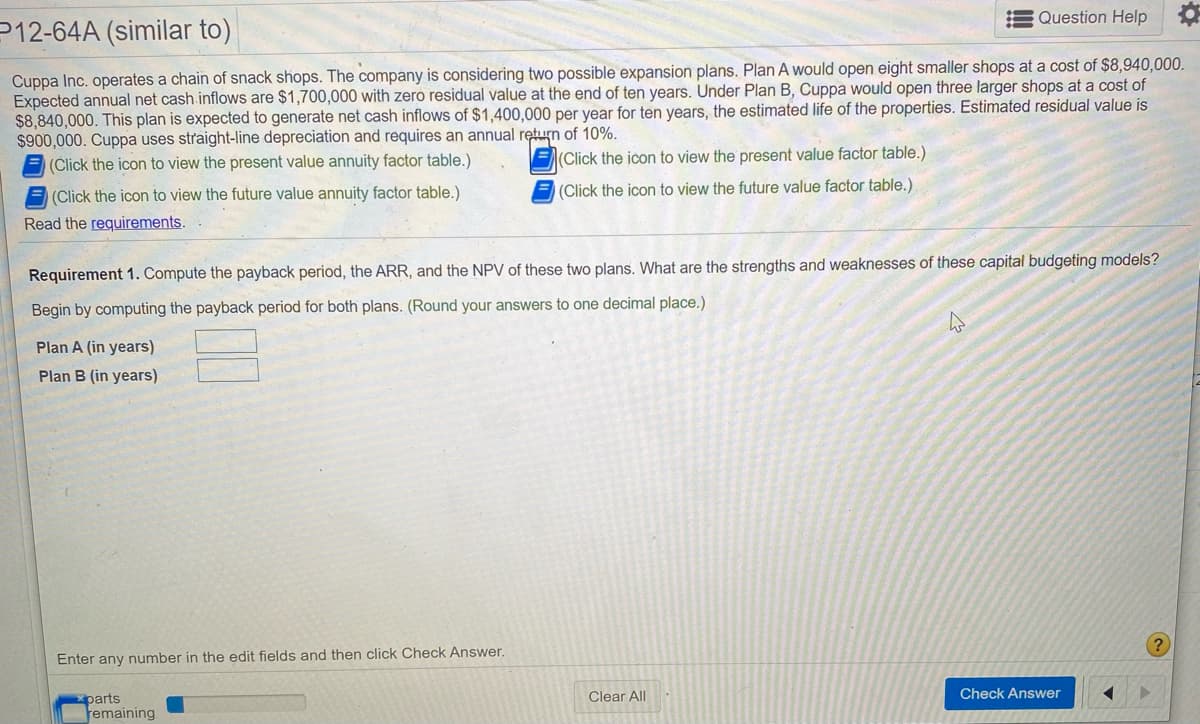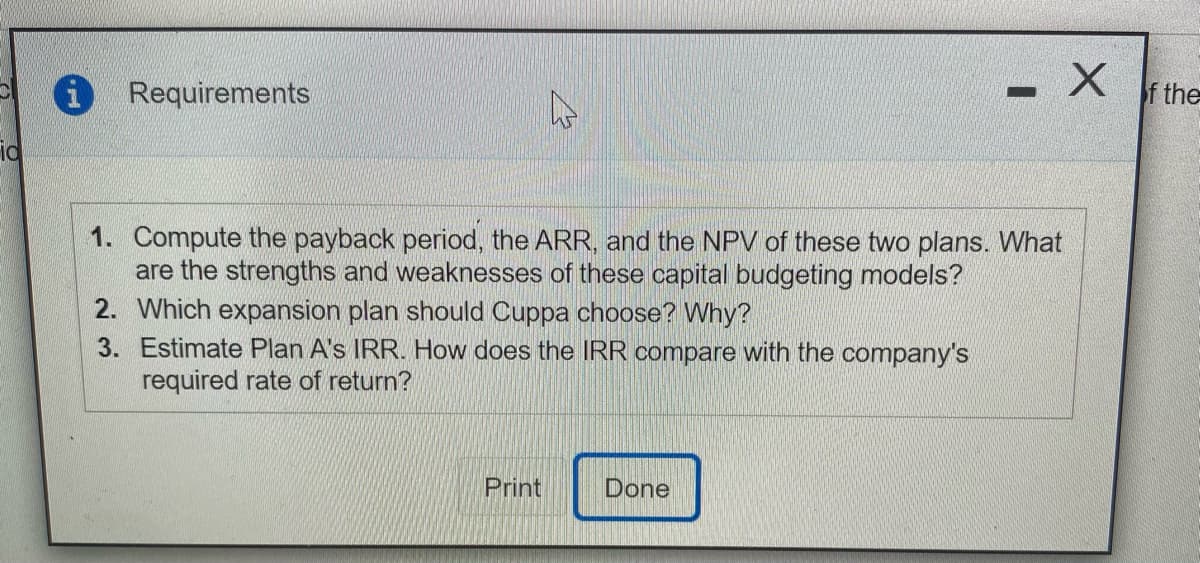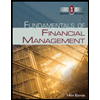Cuppa Inc. operates a chain of snack shops. The company is considering two possible expansion plans. Plan A would open eight smaller shops at a cost of $a8,940,000. Expected annual net cash.inflows are $1,700,000 with zero residual value at the end of ten years. Under Plan B, Cuppa would open three larger shops at a cost of $8,840,000. This plan is expected to generate net cash inflows of $1,400,000 per year for ten years, the estimated life of the properties. Estimated residual value is $900,000. Cuppa uses straight-line depreciation and requires an annual return of 10%. (Click the icon to view the present value annuity factor table.) E(Click the icon to view the present value factor table.) (Click the icon to view the future value annuity factor table.) (Click the icon to view the future value factor table.) Read the requirements.. Requirement 1. Compute the payback period, the ARR, and the NPV of these two plans. What are the strengths and weaknesses of these capital budgeting models? Begin by computing the payback period for both plans. (Round your answers to one decimal place.) Plan A (in years) Plan B (in years)
Cuppa Inc. operates a chain of snack shops. The company is considering two possible expansion plans. Plan A would open eight smaller shops at a cost of $a8,940,000. Expected annual net cash.inflows are $1,700,000 with zero residual value at the end of ten years. Under Plan B, Cuppa would open three larger shops at a cost of $8,840,000. This plan is expected to generate net cash inflows of $1,400,000 per year for ten years, the estimated life of the properties. Estimated residual value is $900,000. Cuppa uses straight-line depreciation and requires an annual return of 10%. (Click the icon to view the present value annuity factor table.) E(Click the icon to view the present value factor table.) (Click the icon to view the future value annuity factor table.) (Click the icon to view the future value factor table.) Read the requirements.. Requirement 1. Compute the payback period, the ARR, and the NPV of these two plans. What are the strengths and weaknesses of these capital budgeting models? Begin by computing the payback period for both plans. (Round your answers to one decimal place.) Plan A (in years) Plan B (in years)
Chapter11: The Cost Of Capital
Section: Chapter Questions
Problem 20PROB
Related questions
Question

Transcribed Image Text:Question Help
P12-64A (similar to)
Cuppa Inc. operates a chain of snack shops. The company is considering two possible expansion plans. Plan A would open eight smaller shops at a cost of $8,940,000.
Expected annual net cash.inflows are $1,700,000 with zero residual value at the end of ten years. Under Plan B, Cuppa would open three larger shops at a cost of
$8,840,000. This plan is expected to generate net cash inflows of $1,400,000 per year for ten years, the estimated life of the properties. Estimated residual value is
$900,000. Cuppa uses straight-line depreciation and requires an annual return of 10%.
(Click the icon to view the present value annuity factor table.)
E(Click the icon to view the present value factor table.)
(Click the icon to view the future value annuity factor table.)
E(Click the icon to view the future value factor table.)
Read the requirements.
Requirement 1. Compute the payback period, the ARR, and the NPV of these two plans. What are the strengths and weaknesses of these capital budgeting models?
Begin by computing the payback period for both plans. (Round your answers to one decimal place.)
Plan A (in years)
Plan B (in years)
Enter any number in the edit fields and then click Check Answer.
Clear All
Check Answer
parts
Femaining

Transcribed Image Text:i Requirements
f the
1. Compute the payback period, the ARR, and the NPV of these two plans. What
are the strengths and weaknesses of these capital budgeting models?
2. Which expansion plan should Cuppa choose? Why?
3. Estimate Plan A's IRR. How does the IRR compare with the company's
required rate of return?
Print
Done
Expert Solution
This question has been solved!
Explore an expertly crafted, step-by-step solution for a thorough understanding of key concepts.
This is a popular solution!
Trending now
This is a popular solution!
Step by step
Solved in 5 steps

Knowledge Booster
Learn more about
Need a deep-dive on the concept behind this application? Look no further. Learn more about this topic, finance and related others by exploring similar questions and additional content below.Recommended textbooks for you


Managerial Accounting
Accounting
ISBN:
9781337912020
Author:
Carl Warren, Ph.d. Cma William B. Tayler
Publisher:
South-Western College Pub

Fundamentals Of Financial Management, Concise Edi…
Finance
ISBN:
9781337902571
Author:
Eugene F. Brigham, Joel F. Houston
Publisher:
Cengage Learning


Managerial Accounting
Accounting
ISBN:
9781337912020
Author:
Carl Warren, Ph.d. Cma William B. Tayler
Publisher:
South-Western College Pub

Fundamentals Of Financial Management, Concise Edi…
Finance
ISBN:
9781337902571
Author:
Eugene F. Brigham, Joel F. Houston
Publisher:
Cengage Learning

Fundamentals of Financial Management (MindTap Cou…
Finance
ISBN:
9781337395250
Author:
Eugene F. Brigham, Joel F. Houston
Publisher:
Cengage Learning

Fundamentals of Financial Management (MindTap Cou…
Finance
ISBN:
9781285867977
Author:
Eugene F. Brigham, Joel F. Houston
Publisher:
Cengage Learning